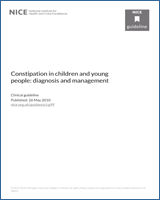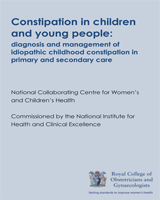NATIONAL INSTITUTE FOR HEALTH AND CLINICAL: EXCELLENCE SCOPE
1. Guideline title
Constipation: the diagnosis and management of idiopathic childhood constipation in primary and secondary care
1.1. Short title
Constipation in children
2. Background
The National Institute for Health and Clinical Excellence (‘NICE’ or ‘the Institute’) has commissioned the National Collaborating Centre for Women's and Children's Health to develop a clinical guideline on the diagnosis and treatment of idiopathic childhood constipation for use in the NHS in England and Wales. This follows referral of the topic by the Department of Health (see
appendix). The guideline will provide recommendations for good practice that are based on the best available evidence of clinical and cost effectiveness.
The Institute's clinical guidelines support the implementation of National Service Frameworks (NSFs) in those aspects of care for which a Framework has been published. The statements in each NSF reflect the evidence that was used at the time the Framework was prepared. The clinical guidelines and technology appraisals published by the Institute after an NSF has been issued have the effect of updating the Framework.
NICE clinical guidelines support the role of healthcare professionals in providing care in partnership with patients, taking account of their individual needs and preferences, and ensuring that patients (and their carers and families, where appropriate) can make informed decisions about their care and treatment.
3. Clinical need for the guideline
Idiopathic (functional) constipation is defined as the subjective complaint of passing abnormally delayed or infrequent dry, hardened faeces (stools) often accompanied by straining and/or pain. It may also be associated with soiling, defined as involuntary passage of fluid or semi-solid stool into clothing, usually as a result of overflow from a faecally loaded bowel. Constipation is termed idiopathic if it cannot be explained by a known cause (anatomical, physiological, radiological or histological abnormalities). The exact aetiology is not fully understood, but it is generally accepted that a combination of factors may contribute to the condition.
There are several ways of characterising constipation by quantifying the timing and passage of stools and qualifying the type of stool. The 'normal' number and type of bowel movements, or defaecation, is dependant on the age of the child. Normal stool frequency in infants and children in industrialised countries ranges from an average of four per day in the 1st week of life to two per day at 1 year of age. The normal adult range (between three per day and three per week) is usually attained by 4 years of age.
Constipation is common in childhood. It is rarely life threatening, and therefore might be expected to have little impact on healthcare provision. The reality is somewhat different, with many children requiring medical and nursing management for a condition that causes great misery and discomfort. In the UK, 5% of children between the ages of 4 and 11 years suffer from constipation lasting more than 6 months. Chronic constipation generally develops between the ages of 1 and 4 years and the pattern of bowel movement tends to be established by the age of 4 years, although childhood constipation may continue beyond puberty in as many as a third of those followed up beyond this age. Children may present with a variety of symptoms that may lead to a diagnosis of idiopathic constipation. As the second most referred condition in paediatric gastroenterology, constipation is estimated to account for at least 25% of visits and often requires prolonged support from a multidisciplinary team.
Acute constipation is short lasting and usually clears up easily with treatment, but it is not always easily recognised or treated appropriately. This may lead to the development of chronic (longstanding) and more serious constipation. Parents are frequently worried about the possibility of serious underlying disease, and the impact of the condition on the family may be considerable -causing distress, disruption and frustration. Families may delay seeking help because they feel that the condition will not be taken seriously.
The majority of children with constipation are seen by their own doctors in primary care. A health visitor may be the first point of contact for families whose newborn or preschool children have constipation. The emergency department may serve as the first port of call for concerned parents of older children. Constipation can be a complex condition to manage and if children do not respond to initial treatment, or if there are concerns regarding underlying disorders, referral to specialist services may be needed.
Currently there is wide variation in practice because:
there are no national evidence-based guidelines to address the diagnosis and management of childhood constipation in England and Wales
the condition may be difficult to recognise because of the diversity of presenting symptoms
the outcomes for children with idiopathic constipation are variable
there is no single treatment
many children do not respond to treatment and continue to have chronic problems
current treatment is often unpleasant, traumatic, invasive and there is believed to be a high level of non-concordance, leading to repeated long-term treatment
children and families are often given conflicting advice.
It is vital that early identification of symptoms, diagnosis, effective treatment and consistent advice and support are offered to children who suffer from constipation and their families. It is also important to differentiate between children with functional constipation (the vast majority) and those with organic disease, so that they all receive appropriate diagnosis and management.
4. The guideline
The guideline development process is described in detail in two publications that are available from the NICE website (see
‘Further information’). The guideline development process: an overview for stakeholders, the public and the NHS' describes how organisations can become involved in the development of a guideline. ‘The guidelines manual’ provides advice on the technical aspects of guideline development.
This document is the scope. It defines exactly what this guideline will (and will not) examine, and what the guideline developers will consider. The scope is based on the referral from the Department of Health (see
appendix).
The areas that will be addressed by the guideline are described in the following sections.
4.1. Population
4.1.1. Groups that will be covered
Newborns, infants and children up to their 18th birthday who have idiopathic constipation.
4.1.2. Groups that will not be covered
Newborns, infants and children who have constipation with a known cause.
4.2. Healthcare setting
Diagnosis and management in community and hospital care, and referral to specialist services.
4.3. Clinical management
Areas that will be covered
Diagnosis of idiopathic constipation, including:
patient history
clinical examination, including the role of digital rectal examination
diagnostic criteria (for example, Rome III criteria)
the following investigations to rule out alternative diagnoses such as Hirschprung's disease or coeliac disease:
- –
blood tests
- –
radiological investigations
- –
gastrointestinal endoscopy
- –
manometry
- –
rectal biopsy.
Management, including:
dietary manipulation, including role of water and milk intake, fruits, vegetables (fibres and roughage), fruit juices, cereals
exclusion of cows' milk protein
physical activity
pharmacological treatments, specifically bulk-forming laxatives, stimulant laxatives and osmotic laxatives
psychological and behavioural management including toilet training, behavioural modification, maintaining toilet diaries, rewarding, psychosocial counselling including biofeedback therapy and intense psychotherapy
complementary and alternative interventions, specifically abdominal massage, reflexology and hypnotherapy
surgical management, including manual evacuation under general anaesthetic and antegrade colonic enema (ACE procedure).
Indications for referral to specialist services.
Information and support needs for children and families.
The Guideline Development Group will take reasonable steps to identify ineffective interventions and approaches to care. If robust and credible recommendations for re-positioning the intervention for optimal use, or changing the approach to care to make more efficient use of resources can be made, they will be clearly stated. If the resources released are substantial, consideration will be given to listing such recommendations in the ‘Key priorities for implementation’ section of the guideline.
Note that guideline recommendations will normally fall within licensed indications; exceptionally, and only if clearly supported by evidence, use outside a licensed indication may be recommended. The guideline will assume that prescribers will use a drug's summary of product characteristics to inform their decisions for individual patients.
Areas that will not be covered
- g.
If during the process of diagnosis for childhood idiopathic constipation another disease is suspected, further diagnosis and treatment of this disease will not be covered.
- h.
Management and diagnosis of comorbidity.
- i.
Care received in specialist services after referral.
- j.
Children with an underlying, congenital, genetic, metabolic, endocrine or neurological disorder may also have constipation. The principles of assessment and management covered in points a–f will apply to them, but the guideline will not address any additional management that these children might require.
4.4. Status
4.4.1. Scope
This is the final scope.
4.4.2. Guideline
The development of the guideline recommendations will begin in May 2008.
4.4.3. Related NICE guidance
Urinary tract infection in children: diagnosis, management and long-term treatment. NICE clinical guideline 54 (2007).
Nocturnal enuresis: the management of nocturnal enuresis (bedwetting) in children and young people. NICE clinical guideline. (Publication expected August 2010.)
5. Further information
Information on the guideline development process is provided in:
These booklets are available as PDF files from the NICE website (www.nice.org.uk/guidelinesmanual). Information on the progress of the guideline will also be available from the website.
Appendix. Referral from the Department of Health
The Department of Health asked NICE:
‘To prepare a clinical guideline on the diagnosis and treatment of idiopathic childhood constipation’.


